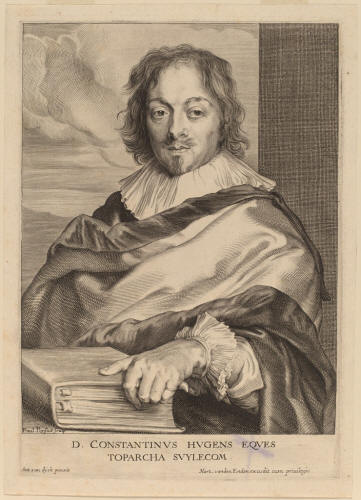Rembrandt's Portrait of a Musician: Can it be Heinrich Schütz ?
Short version: No. [In all likelihood it is Constantijn Huygens].
Longer version with arguments and evidence below.

Rembrandt, Portrait of a Musician (more info, wikimedia commons)
The Corcoran Gallery's "Portrait of a Musician" by Rembrandt—signed and dated 1633, though not 100% sure it is 100% authentical — has caused considerable controversy with regard to the identity of the musician. Three claimants have been presented: Nicholas Lanier, Heinrich Schütz, and Constantijn Huygens. Until a decade ago it was widely accepted that it might be Heinrich Schütz, a theory advanced in 1937 by Bruno Maerker. 5As proof Maerker compared the painting to one of the three known portraits of Schütz—that by Christoph Spetner in the Leipzig University Collection6 (de facto the only authenticated painted portrait, c. 1660. The other certain portrait is an engraving of August John, c. 1627).

Maerker claimed that the subjects of the two works bore striking similarity to one another. (Personal note: Quite odd. The mouth, the hair, the colour of the eyes: all are... strikingly different.)
And: how dit Rembrandt meet Schütz? There is no evidence (not even indirect) that Heinrich Schütz ever visited Amsterdam, let alone in 1633. So most iconographers and Schütz-scholars remained skeptical. In 1963 Otto Benesch did an effort to link Schütz and Rembrandt through their dealings with Burckhardt Grossmann, the son of an acquaintance of Schütz.7 The Maerker-Benesch theory - although still entirely speculative - was accepted by many musicologists, among whom Hans Joachim Moser—Schütz's pre-war biographer8—and Wolfgang Rehm of the Heinrich Schütz Gesellschaft. Benesch imagined Schütz going to Amsterdam as a personal 'detour' while travelling from Dresden to Copenhagen via Hamburg (still quite a detour by the way.) Building such a speculative identification on conjectures only is, in my opinion, not a sign of sound scholarship. On the contrary.
Whereas for Constantijn Huygens, the most plausible candidate, there is quite a lot of supporting evidence. Not only did he have ample opportunity to sit for a portrait by Rembrandt, but comparisons of the Corcoran portrait with authenticated representations of Huygens are most convincing.10 The identification of the musician as being Huygens was made as early as 1942 by the art historian Edith Greindl,11 and has been given further credence in a superb study by Else Kai Sass - already in 1971 ! - who discusses carefully and in detail all literature and available evidence surrounding the Rembrandt portrait.12 Much of the information provided here is drawn from her article.

He was in close contact with the master over a number of years, including 1633. He was Rembrandt's intermediary for many of the works executed for Prince Frederick Henry of Orange. Through Huygens' diaries and correspondence it becomes clear, that he spent a substantial portion of 1633 in The Hague, where Rembrandt may also have been while painting The Elevation of the Cross. Furthermore - against the only objection: he was not a musician, but a diplomate, man of letters - Edith Greindl has pointed out that it is not odd, that Huygens had himself painted with a music scroll. He was proud of his musical accomplishments, both as a composer and a performer.13 These talents had already been highlighted in a portrait painted in 1627 by Thomas de Keyser, where Huygens was depicted with several instruments on the desk nearby.

One may conclude that this fine painting at the Corcoran Gallery was undoubtedly executed by Rembrandt; it does not depict Heinrich Schütz, but rather Constantijn Huygens. In this portrait Rembrandt appears to have memorialized the musical accomplishments of the public official and amateur musician with whom he had dealt on so many occasions.
5Bruno
Maerker, "Rembrandts Bildnis eines Musikers—Ein Schütz-Portrait?", in Deutsche
Musikkultur 2 (1937-38), 329-45.
6The miniature oil-painting (Deutsche Staatsbibliothek in Berlin), 'discovered' in 1936, depicting Schütz 85-year old is a fraud (1929-1935). It was long accepted as authentical. See: Wolfram Steude, "Zum gegenwärtigen Stand der Schütz-Ikonographie", in Schütz-Jahrbuch 1985/86. Bärenreiter, Kassel 1986, p. 58-61. See also Walter Werbeck, Schütz Handbuch, p. 18. It's all about 'image-buiding'. The etching of August John of the 42 year old Schütz depicts him as the Kapellmeister of the electoral court of Dresden.
7Otto
Benesch, "Schütz and Rembrandt," Festschrift Otto Erich Deutsch, ed.
Walter Gerstenberg (Kassel: Bärenreiter, 1963), 12-19.
8Hans
Joachim Moser, Heinrich Schütz: Sein Leben und Werk, 2nd rev. ed.
(Kassel: Bärenreiter, 1954),
625.
10Among
the authenticated portraits of Huygens are included an engraving by Paulus
Pontius after Van Dyck, which was executed in 1632; a grisaille by Jan Mauris
Quinkhard, now in the Amsterdam Rijksmuseum; a painting by Jan Lievens, housed
in the Rijksmuseum; and a painting by Thomas de Keyser from 1627 that is in the
National Gallery in London.
11Edith
Greindl, "Un portrait de Constantin Huygens par Rembrandt," Apollo (March
1942), 10-11.
12Else
Kai Sass, "Constantijn Huygens—The Musician," in Comments on Rembrandt's
Passion Paintings and Constantijn Huygens's Iconography, by Else Kai Sass,
transl. Jean Nixon and David Hohnen (Copenhagen: Munksgaard, 1971),
39-61.
13Greindl, pp. 10-11.
